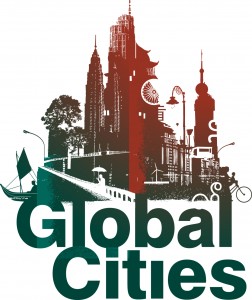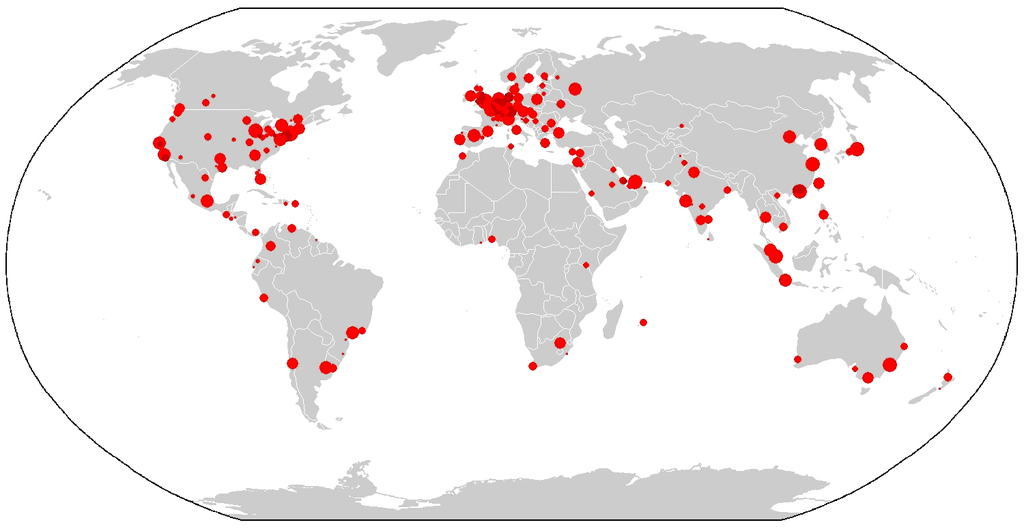Global Cities
junio 27, 2014 · Imprimir este artículo
Global Cities
Mayors from the Hong Kong, Singapore, Moscow and London debate why high net worth investors are investing their cities.
Source: Knight Frank TV.
More information: http://www.thewealthreport.net/
See more at: http://www.thewealthreport.net/#sthash.GCLH9fSP.dpuf
———————————————————————————————–
Ciudad global
 Ciudad global (también llamada ciudad mundial, ciudad alfa o centro), es un concepto de geografía urbana promovido por el departamento de geografía de la Universidad de Loughborough. El término ciudad global se atribuye a la socióloga Saskia Sassen, autora del libro publicado en 1991 La ciudad global.
Ciudad global (también llamada ciudad mundial, ciudad alfa o centro), es un concepto de geografía urbana promovido por el departamento de geografía de la Universidad de Loughborough. El término ciudad global se atribuye a la socióloga Saskia Sassen, autora del libro publicado en 1991 La ciudad global.
Se aplica a las ciudades que cumplen con una serie de características nacidas debido al efecto de la globalización y al constante crecimiento de la urbanización. Las más complejas de estas entidades serían las «ciudades globales»: las que tienen un efecto directo y tangible en los asuntos mundiales a través de algo más que el medio socio-económico, con influencia en términos de la cultura o la política. Fue acuñado bibliográficamente por Saskia Sassen, en referencia a Londres, Nueva York, París y Tokio, y en contraposición con el término megaciudad, en su obra de 1991 titulada La Ciudad Global.
Características generales
Conocimiento y familiaridad a nivel internacional de la ciudad. Un ejemplo de esto es el reconocimiento del nombre, es decir, el nombre de la ciudad refiere directamente a ella y no a otro término.
Influencia y participación en eventos internacionales y aspectos de importancia mundial, como por ejemplo, la realización de grandes reuniones deportivas (Juegos Olímpicos o Copa Mundial de Fútbol, por decir algunos), políticas o sociales, o ser sede de organismos internacionales.
Ser centro de una gran conurbación y poseer una población en el área metropolitana suficientemente grande.
Tener un aeropuerto que funcione como un hub internacional, es decir que tenga un gran número de conexiones aéreas con las grandes ciudades del mundo.
Tener un avanzado sistema de transporte dentro de la ciudad y con otras ciudades.
Tener una infraestructura avanzada en el mundo de las telecomunicaciones.
Que sea una ciudad cosmopolita.
Tener un ambiente cultural propio, gracias a la existencia de festivales de cine, eventos musicales, galerías de arte, etc.
Ser sede de diversas empresas de nivel internacional y actividades (ferias, bolsa) que la definan como una importante ciudad de negocios.
Para algunos, Londres, Nueva York, París y Tokio han sido tradicionalmente consideradas las «cuatro grandes» ciudades de todo el mundo no por casualidad, sino que también sirven como símbolos del capitalismo global. Sin embargo, muchas personas tienen sus propias listas personales, y cualquiera de las listas es probable que difieran sobre la base de antecedentes culturales, valores, y experiencia.
Fuente: Wikipedia, 2014.
—————————————
Global city
A global city (also called world city or sometimes alpha city or world center) is a city generally considered to be an important node in the global economic system. The concept comes from geography and urban studies and rests on the idea that globalization can be understood as largely created, facilitated, and enacted in strategic geographic locales according to a hierarchy of importance to the operation of the global system of finance and trade.
The most complex of these entities is the «global city,» whereby the linkages binding a city have a direct and tangible effect on global affairs through socio-economic means. The use of «global city,» as opposed to «megacity,» was popularized by sociologist Saskia Sassen in her 1991 work, The Global City: New York, London, Tokyo though the term «world city» to describe cities that control a disproportionate amount of global business dates to at least the May 1886 description of Liverpool by The Illustrated London News. Patrick Geddes also used the term «world city» later in 1915. Cities can also fall from such categorization, as in the case of cities that have become less cosmopolitan and less internationally renowned in the current era.
Criteria
Global city status is considered to be beneficial and desired, and because of this many groups have tried to classify and rank which cities are seen as world cities or non-world cities. Although there is a consensus upon leading world cities, the criteria upon which a classification is made can affect which other cities are included. The criteria for identification tend either to be based on a yardstick value (e.g., if the producer-service sector is the largest sector then city X is a world city) or on an imminent determination (if the producer-service sector of city X is greater than the combined producer-service sectors of N other cities then city X is a world city.)
Characteristics
Although what constitutes a world city is still subject to debate, standard characteristics of world cities are:
A variety of international financial services, notably in finance, insurance, real estate, banking, accountancy, and marketing
Headquarters of several multinational corporations
The existence of financial headquarters, a stock exchange and major financial institutions
Domination of the trade and economy of a large surrounding area
Major manufacturing centres with port and container facilities
Considerable decision-making power on a daily basis and at a global level
Centres of new ideas and innovation in business, economics, culture and politics
Centres of media and communications for global networks
Dominance of the national region with great international significance
High percentage of residents employed in the services sector and information sector
High-quality educational institutions, including renowned universities, international student attendance[8] and research facilities
Multi-functional infrastructure offering some of the best legal, medical and entertainment facilities in the country
Studies
GaWC study
A map showing the distribution of GaWC-ranked world cities (2010 data)
The first attempt to define, categorize and rank global cities using relational data was made in 1998 by Jon Beaverstock, Richard G. Smith and Peter J. Taylor, who all worked at the time at Loughborough University in the United Kingdom.[9] Together, Beaverstock, Smith and Taylor established the Globalization and World Cities Research Network (GaWC). A roster of world cities was outlined in the GaWC Research Bulletin 5 and ranked cities based on their connectivity through four «advanced producer services»: accountancy, advertising, banking/finance, and law. The GaWC inventory identifies three levels of global cities and several sub-ranks.
The 2004 rankings acknowledged several new indicators while continuing to rank city economics more heavily than political or cultural factors. The 2008 roster, similar to the 1998 version, is sorted into categories of «Alpha» world cities (with four sub-categories), «Beta» world cities (three sub-categories), «Gamma» world cities (three sub-categories) and additional cities with «High sufficiency» or «Sufficiency» presence. The following is a general guide to the rankings:
Alpha++ cities are London and New York City, which are vastly more integrated with the global economy than all other cities.
Alpha+ cities complement London and New York City by filling advanced service niches for the global economy.
Alpha and Alpha- cities are cities that link major economic regions into the world economy.
Beta level cities are cities that link moderate economic regions into the world economy.
Gamma level cities are cities that link smaller economic regions into the world economy.
Sufficiency level cities are cities that have a sufficient degree of services so as not to be obviously dependent on world cities.
Source: Wikipedia, 2014.
—————————————






Comentarios
Algo para decir?
Usted debe estar logueado para escribir un comentario.